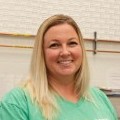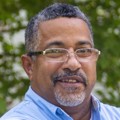Documents
EIC Whitepaper
https://arxiv.org/abs/1212.1701
Nuclear Physic Long Range Plan 2015
https://science.energy.gov/~/media/np/nsac/pdf/2015LRP/2015_LRPNS_091815.pdf
EIC Whitepaper
https://arxiv.org/abs/1212.1701
Nuclear Physic Long Range Plan 2015
https://science.energy.gov/~/media/np/nsac/pdf/2015LRP/2015_LRPNS_091815.pdf
Jefferson Lab EIC (JLEIC) Design Parameter (Apr. 2019 update: 100 GeV CM)
EIC Detector Simulations
Laboratory Directed R&D Pages
JLEIC Public Documents
JLEIC Detector and IR Study Group
The US Electron Ion Collider (EIC) has received the endorsement of the National Academy of Sciences committee last year – an important milestone along the path to realizing an EIC in the US. With this in mind, the Jefferson Lab EIC Center (EIC2, see www.eiccenter.org) established a Visitors-Program for summer 2019 to help begin to investigate, more quantitatively than previously, various aspects of the EIC. This Program will occur under the auspices of Jefferson Lab’s EIC Center; proposals for projects can be EIC site independent. Efforts have been underway to simulate science opportunities and detector performance within a generic EIC software umbrella, and similarly collaborative efforts are ongoing related to accelerator and detector R&D.
The envisioned visits to Jefferson Lab would take place between now and mid-September and would be 1 to 2 weeks duration with travel expenses including hotel and airfare covered by the laboratory. The visitors will be chosen by the EIC2 Director and Co-Directors based on a written proposal that outlines:
The possible projects to be proposed include (but are not limited to)
Examples of project deliverables can be a plot with EIC-projected conceptual data illustrating EIC energy, polarization, luminosity or versatility needs; a detector conceptualization including possible channel count and requirements; conceptualization towards polarization, luminosity and background measurements at an EIC; conceptualization of accelerator elements for diagnostics and beam transport and manipulation; and other such examples. We request the project deliverable, in the form of a one-to-two page document, to be submitted latest the last day of the visit.
If interested, please send a written proposal containing points 1 to 4 above in no more than two pages, to Douglas Higinbotham <doug@jlab.org>.
We are currently open to receive proposals and will continue to be so contingent upon funding availability.
Jefferson Lab has a rich history of doing parasitic detector tests in the experimental halls to ensure successful future experiments. One very high impact example was the test of neutron detector shielding in Hall A, which demonstrated how to clearly best shield the neutron detector and allow the triple coincidence short-range correlation experiment to proceed. This led to Hall A's first publication in the journal, Science.
Areas at Jefferson Lab where parasitic testing is possible are the high luminosity Halls A and C, and the low luminosity Hall B and Hall D. Dedicated testing is possible using the upgraded injector test facility, a 10 MeV electron beam area.
To order to do tests in any of these areas, the following must occur:
It is expected that the group doing the test will provide the detectors and electronics. Minimum help is needed from hall technical staff.
A copy of the Jefferson Lab beam schedule to the four experimental halls can be found here.
To facilitate outside groups who wish to test detectors for the future EIC in an electron beam environment, the EIC center is accepting requests and will help in determining which area at the lab would be best suited for a particular test. The EIC center will also help explain the training and safety requirement of Jefferson Lab to new users.
Further details about the areas and equipment avaliable in Hall B can be found here
Contact Douglas Higinbotham for more details.
Webpages
Center for Frontier in Nuclear Science
National Academy of Sciences: US based Electron-Ion Collider Assessment
eRHIC Wiki- An Electron-Ion Collider at BNL
Generic Detector R&D for the Electron Ion Collider
Documents
NASEM Report: An Assessment of U.S.-Based Electron-Ion Collider Science
Nuclear Physic Long Range Plan 2015
European Particle Physics Strategy 2020 submissions
EIC2@JLab Director:
Douglas Higinbotham
(757) 269-7851
Media Contact:
Lauren Hansen
Communications Manager
(757) 269-7689
lhansen@jlab.org
https://www.jlab.org/pressroom
The Electron-Ion Collider Center at Jefferson Lab (EIC2@JLab) is an organization to advance and promote the science program at a future electron-ion collider (EIC) facility. Particular emphasis is on the close connection of EIC science to the current Jefferson Lab 12 GeV CEBAF science program.
EIC2@JLab consolidates and connects the EIC physics and detector development activities in and around Jefferson Lab. These activities include:
Further, EIC2 coordinates with the following activities:
In addition, EIC2 establishes the following new activities:
The Thomas Jefferson National Accelerator Facility (Jefferson Lab) is located at 12000 Jefferson Avenue in Newport News, Virginia.
Main block text dlkndfl sdn kjndfl sdnlnfvlsdnfls kdjnsdlkf jndsklfdsnf lkdsfn kdjnfsknd o ivn sn nv dsinvdlsn vsdo ndslovn dsoMain block text dlkndfl sdn kjndfl sdnlnfvlsdnfls kdjnsdlkf jndsklfdsnf lkdsfn kdjnfsknd o ivn sn nv dsinvdlsn vsdo ndslovn dsoMain block text dlkndfl sdn kjndfl sdnlnfvlsdnfls kdjnsdln nv dsinvdlsn vsdo ndslovn dsoMain block text dlkndfl sdn kjndfl sdnlnfvlsdnfls kdjnsdlkf jndsklfdsnf lkdsfn kdjnfsknd o ivn skf jndsklfdsnf lkdsfn kdjnfsknd o ivn sn nv dsinvdlsn vsdo ndslovn dsoMain block text dlkndfl sdn kjndfl sdnlnfvlsdnfls kdjnsdlkf jndsklfdsnf lkdsfn kdjnfsknd
Accelerate your career with a new role at the nation's newest national laboratory. Here you can be part of a team exploring the building blocks of matter and lay the ground work for scientific discoveries that will reshape our understanding of the atomic nucleus. Join a community with a common purpose of solving the most challenging scientific and engineering problems of our time.
A career at Jefferson Lab is more than a job. You will be part of “big science” and work alongside top scientists and engineers from around the world unlocking the secrets of our visible universe. Managed by Jefferson Science Associates, LLC; Thomas Jefferson National Accelerator Facility is entering an exciting period of mission growth and is seeking new team members ready to apply their skills and passion to have an impact. You could call it work, or you could call it a mission. We call it a challenge. We do things that will change the world.
At Jefferson Lab we believe in giving back to our community and encouraging the next generation of scientists and engineers. Our staff reaches out to students to advance awareness and appreciation of the range of research carried out within the DOE national laboratory system, to increase interest in STEM careers for women and minorities, and to encourage everyone to become a part of the next-generation STEM workforce. We are recognized for our innovative programs like:
1,500 students from 15 Title I schools engage in the Becoming Enthusiastic About Math and Science (BEAMS) program at the lab each school year.
60 teachers are enrolled in the Jefferson Science Associates Activities for Teachers (JSAT) program at the lab inspiring 9,000 students annually.
24 high school students have internships and 34 college students have mentorships at the lab.















When planning began for Jefferson Lab’s Gluonic Excitations Experiment (GlueX) in the early 1990s, Justin Stevens was in elementary school. He had no idea that one day he would help design a critical detector for phase two of the multi-decade project or that he would play the critical role of physics analysis coordinator.
Stevens began his career at Indiana University, where he conducted research at the U.S. Department of Energy’s Brookhaven National Laboratory in pursuit of his Ph.D. From there, he moved to Boston in 2012 for a postdoctoral position at the Massachusetts Institute of Technology.
It was during his time at MIT that he began working on the conceptual design for a detector critical for phase two of GlueX, the DIRC (Detection of Internally Reflected Cherenkov light) detector. GlueX began data taking with the completed detector in December 2019.
Multi-institution coordination
While developing the DIRC detector at MIT and later as a staff scientist at Jefferson Lab, Stevens had his first taste of what his future on the GlueX project would be like. He discovered that he could have a pivotal role in the project by combining his instincts for project management with his cross-institution coordination skills. Much of his success in his role has come from his willingness to take on the management side of an experiment in addition to the research itself.
“Our team at MIT was putting together a proposal for what the detector would look like,” he recalls. “We were looking at our options and it turned out that a significant component of the detector was available at DOE’s SLAC National Accelerator Laboratory in California. These were components that were quite expensive to build—five-meter-long silica bars that were very challenging to machine and keep polished. They weren’t being used at SLAC anymore.”
The GlueX collaboration put in a request to use the bars at Jefferson Lab. The request was approved, so the team got to work determining the safest way to transport the fragile material from California to their future home in Hall D at Jefferson Lab. To ensure the successful transportation of the bars, Stevens worked with a group at MIT and Indiana University to build well-cushioned crates that would be pulled across the country by a semi-trailer.
Learning on the job
Stevens says he has learned additional project management skills through his work on GlueX. In 2016, he assumed a three-year bridge appointment position at Jefferson Lab and William & Mary. A bridge appointment is a reciprocal relationship that Jefferson Lab has with local universities whereby the lab helps to fund faculty positions at universities in exchange for having those faculty members and their students research at the lab.
He admits that the position permitted him to learn much about his roles by being on the job.
“As a physicist, we do a little bit of everything,” he explains. “The lab has an extremely good group of engineers that are good at designing and engineering the specifications for the detector we’re interested in. When I was hired by the lab, part of my job was to manage this $1.8 million project. There were things like budgeting and procurement that I had to learn on the fly.”
Stevens says he turned to his colleagues at the lab for guidance.
“Project management of these large experiments is not something we learn as physics graduate students,” Stevens admits. “Part of my job description was to make this detector a reality and to do that, we had to negotiate with the lab for funding to build the device, work with universities and establish a manageable timeline for the project. I had a lot to learn and an excellent team at the lab to help guide me.”
Encouraging future scientists
Now, as an assistant professor at William & Mary, Stevens continues to include his students on research at the lab, where they can learn hands-on.
“There are unique advantages of having a big, national laboratory nearby William & Mary,” Stevens says. “The undergraduate students that work with me at William & Mary can come with me to the lab. An undergraduate student across the country can do analysis, but not actually see the experiment they’re working on.”
Stevens reports that in addition to the undergraduate and graduate students in the William & Mary physics department, there are roughly 60 physics Ph.D. candidates and nine faculty members working on nuclear physics at the school.
Stevens says that he intends to continue to enable physics students to contribute to the lab’s experiments in meaningful ways.
“Phase two of GlueX that uses this new detector should take about four years to run to completion,” he explains. “It’s a long experiment and it takes time to process and analyze the data. My graduate students will have several years of data analysis on this experiment alone, and I expect that I will have students analyzing data from GlueX for a decade.”
By Carrie Rogers
The Jefferson Lab campus is located in southeastern Virginia amidst a vibrant and growing technology community with deep historical roots that date back to the founding of our nation. Staff members can live on or near the waterways of the Chesapeake Bay region or find peace in the deeply wooded coastal plain. You will have easy access to nearby beaches, mountains, and all major metropolitan centers along the United States east coast.
To learn more about the region and its museums, wineries, parks, zoos and more, visit the Virginia tourism page, Virginia is for Lovers.
To learn more about life at Jefferson Lab, click here.
We support our inventors! The lab provides resources to employees for the development of patented technology -- with over 180 awarded to date! Those looking to obtain patent coverage for their newly developed technologies and inventions while working at the lab are supported and mentored by technology experts, from its discovery to its applied commercialization, including opportunities for monetary awards and royalty sharing. Learn more about our patents and technologies here.

“Chemistry is the art of science and art; you’re manipulating and creating things. We have lots of different recipes to work with.”

"Today, we use a lot of those same teamwork traits [learned from the military] on a daily basis as we're all working toward similar goals here at the lab in better understanding nuclei!"

"Everybody in the chain is working towards the same goal: to ensure that everything is built safe and to the code specifications"

“Here at the lab you get to see what you’ve worked on. You can hold it in your hands. It’s rewarding to know that you’ve played a part in helping the machine to be successful.”

“Generally, the mechanical engineers at the lab support the physicists. The physicists have the big ideas about how to support new science, and the engineers figure out how to make that happen.”
Jefferson Science Associates, LLC manages and operates the Thomas Jefferson National Accelerator Facility. Jefferson Science Associates/Jefferson Lab is an Equal Opportunity and Affirmative Action Employer and does not discriminate in hiring or employment on the basis of race, color, religion, ethnicity, sex, sexual orientation, gender identity, national origin, ancestry, age, disability, or veteran status or on any other basis prohibited by federal, state, or local law.
If you need a reasonable accommodation for any part of the employment process, please send an e-mail to recruiting @jlab.org or call (757) 269-7100 between 8 am – 5 pm EST to provide the nature of your request.
JSA is an E-Verify Employer
`

A Proud V3-Certified Company
JSA/Jefferson Lab values the skills, experience and expertise veterans can offer due to the myriad of experiences, skill sets and knowledge service members achieve during their years of service. The organization is committed to recruiting, hiring, training and retaining veterans, and its ongoing efforts has earned JSA/Jefferson Lab the Virginia Values Veterans (V3) certification, awarded by the Commonwealth of Virginia.